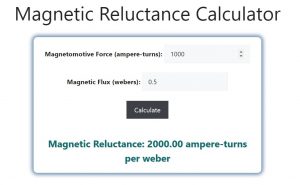About Magnetic Reluctance Calculator (Formula)
The Magnetic Reluctance Calculator is a valuable tool for engineers and physicists working with magnetic circuits. Understanding magnetic reluctance is crucial for designing efficient magnetic systems, such as transformers, inductors, and magnetic coils. This article will explain the formula used in the calculator, guide you through the process of using it, provide an example for clarity, and answer frequently asked questions related to magnetic reluctance calculations.
Formula
The formula to calculate magnetic reluctance is:
Reluctance (R) = Magnetomotive Force (F) / Magnetic Flux (Φ)
In this formula, R represents reluctance, F is the magnetomotive force measured in ampere-turns, and Φ is the magnetic flux measured in webers. This relationship highlights how the reluctance of a magnetic circuit affects its efficiency and performance.
How to Use
- Measure the Magnetomotive Force (F):
Determine the magnetomotive force, typically calculated as the product of the current flowing through the coil and the number of turns in the coil (in ampere-turns). - Measure the Magnetic Flux (Φ):
Measure or calculate the magnetic flux in the circuit. This can be done using sensors or analytical methods. - Apply the Formula:
Insert the values for F and Φ into the formula to calculate the reluctance. - Result:
The result will give you the reluctance of the magnetic circuit, expressed in ampere-turns per weber (At/Wb).
Example
Let’s consider a magnetic circuit with the following specifications:
- Magnetomotive Force (F): 1000 At
- Magnetic Flux (Φ): 0.5 Wb
Using the formula:
Reluctance (R) = Magnetomotive Force (F) / Magnetic Flux (Φ)
Reluctance (R) = 1000 At / 0.5 Wb
Reluctance (R) = 2000 At/Wb
Thus, the magnetic reluctance of the circuit is 2000 ampere-turns per weber.

FAQs
1. What is a Magnetic Reluctance Calculator?
A Magnetic Reluctance Calculator is a tool used to determine the reluctance in magnetic circuits, helping in the design and analysis of magnetic systems.
2. Why is magnetic reluctance important?
Magnetic reluctance is critical for understanding how easily magnetic flux can pass through a material, affecting the efficiency of magnetic circuits.
3. What is the unit of reluctance?
The unit of reluctance is ampere-turns per weber (At/Wb).
4. How is magnetomotive force (F) calculated?
Magnetomotive force is calculated as the product of current (in amperes) and the number of turns in the coil.
5. What is magnetic flux (Φ)?
Magnetic flux is the total magnetic field passing through a given area, measured in webers (Wb).
6. How does the material of the magnetic circuit affect reluctance?
Different materials have different permeabilities, affecting the reluctance; higher permeability materials reduce reluctance.
7. Can I use this calculator for different types of magnetic circuits?
Yes, this calculator is applicable to any magnetic circuit as long as you have the necessary parameters.
8. How do I ensure accurate measurements for F and Φ?
Use calibrated measuring instruments and ensure that the measurements are taken under consistent conditions.
9. What factors can influence magnetic reluctance?
Factors include the geometry of the magnetic circuit, the material properties, and the applied magnetomotive force.
10. Can reluctance be negative?
No, reluctance is always a positive value, representing opposition to magnetic flux.
11. How does temperature affect magnetic reluctance?
Temperature changes can affect the magnetic properties of materials, potentially altering reluctance.
12. How can I use reluctance calculations in transformer design?
Understanding reluctance helps in optimizing the core material and geometry to improve transformer efficiency.
13. What is the relationship between reluctance and inductance?
Inductance is inversely proportional to reluctance; lower reluctance results in higher inductance.
14. What are the practical applications of calculating magnetic reluctance?
Applications include designing transformers, inductors, magnetic sensors, and motors.
15. Can I use this calculator for air gaps in magnetic circuits?
Yes, air gaps significantly increase reluctance, and this calculator can be used to analyze their impact.
16. What tools are commonly used to measure magnetic flux?
Common tools include fluxmeters, Hall effect sensors, and magnetometers.
17. How do changes in coil turns affect reluctance?
Increasing the number of turns increases magnetomotive force, which can decrease reluctance if magnetic flux remains constant.
18. Is it possible to calculate reluctance without direct measurements?
Yes, you can use known properties of materials and geometrical dimensions to estimate reluctance.
19. How can I improve the efficiency of a magnetic circuit?
Using materials with low reluctance and optimizing the geometry of the circuit can significantly enhance efficiency.
20. Where can I find more information on magnetic circuits and reluctance?
Resources include physics textbooks, engineering manuals, and online courses focused on electromagnetism.
Conclusion
The Magnetic Reluctance Calculator is an essential tool for engineers and physicists involved in designing and analyzing magnetic circuits. By understanding and accurately calculating magnetic reluctance, you can enhance the efficiency and performance of various magnetic systems. This knowledge is crucial for applications ranging from transformers to inductors, ensuring that your designs meet the required specifications effectively.
